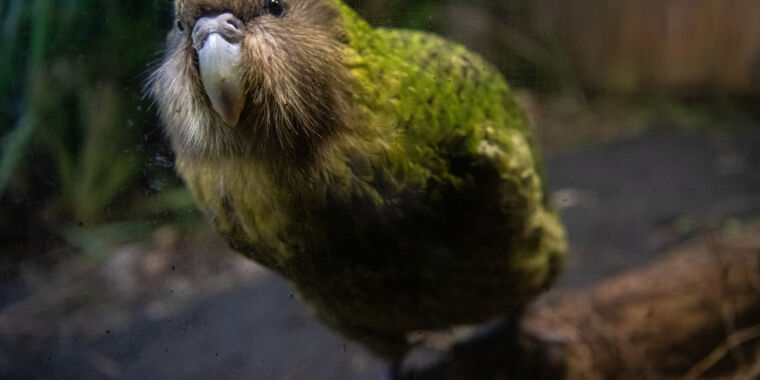An eerie sound echoes through the night in the shadows of a virgin forest on an island off the coast of New Zealand.That’s deep boom It can sometimes be heard from miles away. This is the mating call of one of the region’s strangest and most interesting creatures.Meet endangered species Kakapo.
The kakapo (its name means “night parrot” in Maori) is a large flightless parrot endemic to New Zealand. 1894, conservationist richard henry They relocated mainland birds to a supposedly safe island, but encountered an unexpected predator. In the 1970s, more kakapo were discovered on the mainland and several surrounding islands. Mainland birds were later relocated to those islands, but only one survived.he was there appropriately named Richard Henry.
This unique parrot now roams five islands with no natural predators, and its population has increased from a precarious 51 individuals in 1995 to 252 individuals in 2022. Still, the limited genetic diversity of such a small population makes reproduction problematic. Breeding programs have revealed that most kakapo are heavily inbred, making them susceptible to disease and infertility. In an unprecedented effort to save species, University of Otago They have now sequenced the genomes of nearly all extant birds to see if there are genetic variations within the population that could help prevent the kakapo from becoming extinct.
Will it bear fruit and multiply?
Once abundant on mainland New Zealand, the kakapo began to face new threats with the arrival of humans. The first Polynesian settlers hunted them for food and brought with them predatory dogs. Other predators such as rats, possums, stoats, ferrets, and feral cats were later introduced by European settlers. As a result, very few birds remained and the gene pool was severely limited.
Previous efforts to revive kakapo populations have included genetic testing. Although the first individual’s genome was sequenced in 2016, there were many unknowns about the genetic variations that other individuals carry. Sequencing a single organism can tell us something about the genetic diversity of that species, but conservation efforts are most beneficial when genetic information is available from as many individuals as possible.
Sequencing entire populations can find where the most undesirable genetic mutations are located within a population, allowing scientists to avoid breeding birds that are too closely related or have too many harmful mutations. can do.
The team behind the new study was looking for mutations associated with fertility and disease. The kakapo’s fertility is disastrous. Many eggs never hatch due to infertility or death of the embryo. Further complicating reproductive issues, the parrot’s lifespan is estimated to be 80 to 100 years, and young birds take many years to reach sexual maturity. They reproduce only every 2-3 years when plants like rimu trees bear fruit in large quantities.
For these reasons, and the problem with breeding kakapo in the wild, as males outnumber females (they don’t lay eggs in the first place), scientists have resorted to artificial insemination. The ability to select male sperm that has the most beneficial mutations or is most genetically compatible with a particular female has been shown to reduce problems associated with inbreeding. The Otago team has the genetic arrangement of almost the entire population, which gives them an added advantage in terms of which kakapo genes to combine.
“At the population level, [our method] “We can estimate the number and magnitude of the genetic variations that contribute to differences between individuals,” they write in a new paper. “This genetic ‘structure’ directly influences the ability of small populations to adapt in response to selection.”
If the genes match
Generating genetic diversity among inbred kakapo populations has previously been attempted by interbreeding individuals assumed to be unrelated, even when the exact degree of relatedness is unknown.short repeating segments of DNA known as microsatellite It was used to test the kinship of the parents. The problem is that microsatellites often make inaccurate estimates of which individuals are most and least relevant. Because kakapo are so long-lived, researchers have had access to the genomes of nearly every bird that started our current population (including the late Richard Henry).
By analyzing the genomes of entire populations, scientists were able to identify regions where specific mutations were associated with traits. Phenotypes such as growth rate and disease susceptibility may also be considered in breeding decisions. By combining individuals with promising genotypes and favorable phenotypes throughout the population, kakapo have the best chance of continuing to produce viable offspring. This resulted in the birds being relocated to another island to provide more genetically suitable mates.
The most genetically diverse individual was found to be Richard Henry, the only bird introduced from the mainland that survived to breeding. This genetic diversity compared to the island kakapo is thought to be due to the bird’s origin from mainland populations. Although mutations exist in Richard Henry’s genome, many of those mutations are recessive and therefore unlikely to manifest, and a number of mutations present a greater chance for the fertility and overall fitness of future offspring. It was also found that there are more.
It is fitting that the Kakapo with the most valuable genes are from Fiordland. The return of flightless parrots once seemed like a fantasy, but the sequencing of the genomes of nearly all existing parrots could lead not only to the recovery of parrot populations but also to the revival of other endangered species. There is.
Natural Ecology and Evolution, 2023. DOI: 10.1038/s41559-023-02165-y


